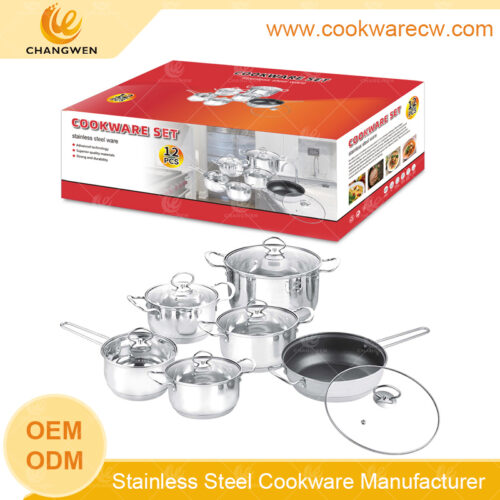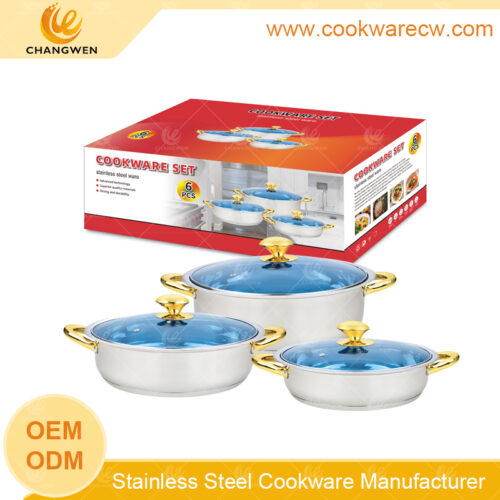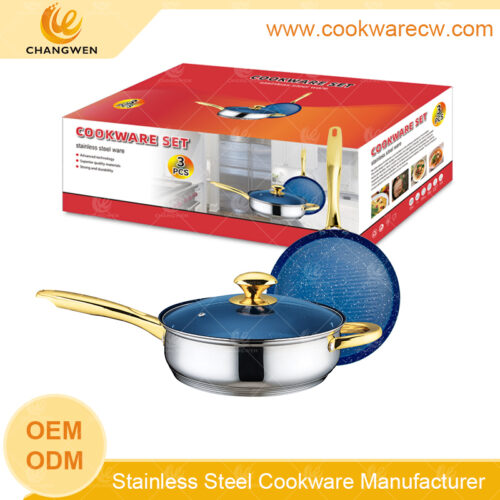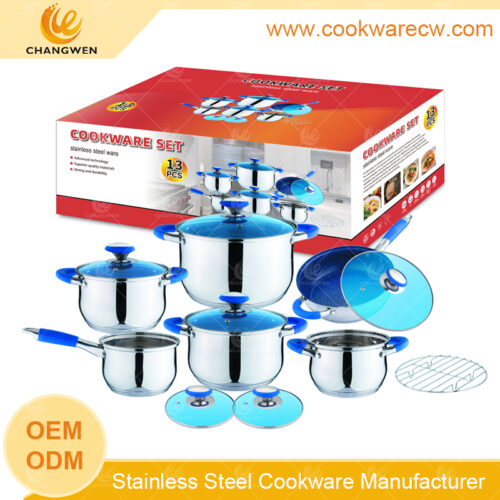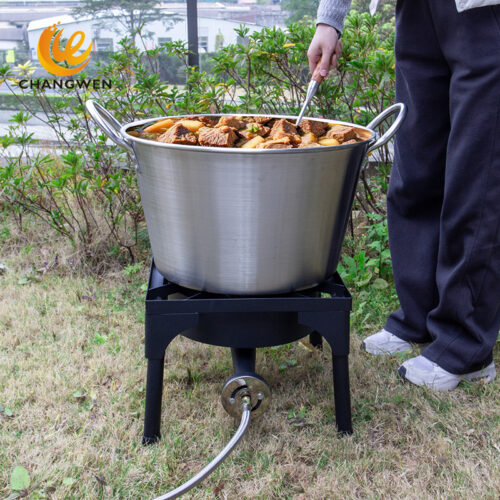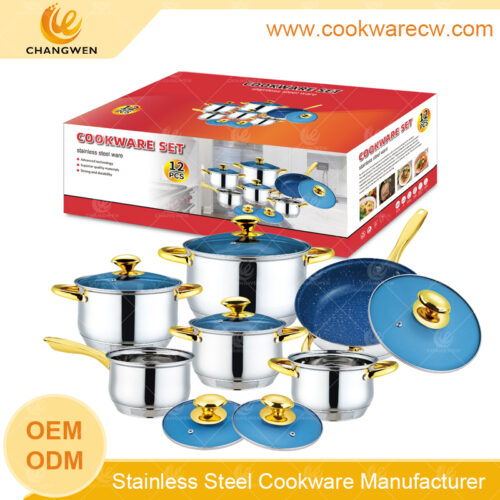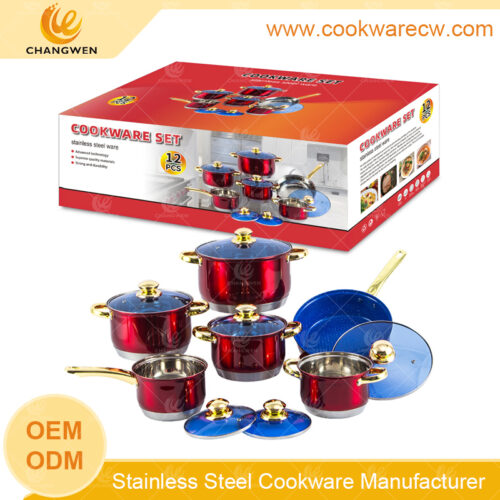Blog
Changwen is a leading cooking utensils manufacturers. We supply high quality stainless steel cooking pots and pans to all over the world. We can also customize the local hot-selling stainless steel pots and pans. Please send your requirements to Changwen.
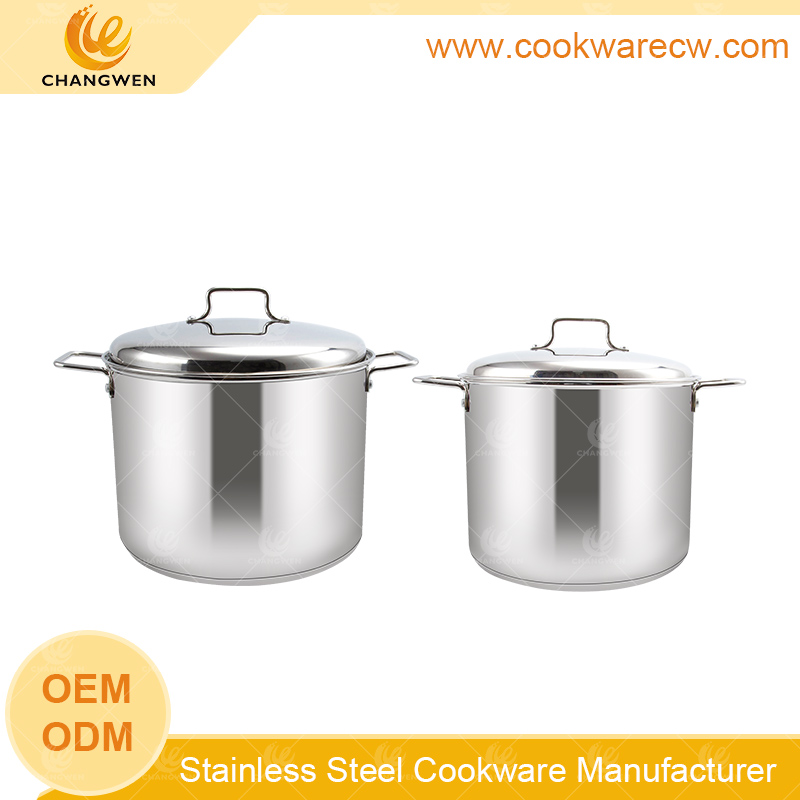
Aluminum vs Stainless Steel Cookware: A Comprehensive Analysis and Comparison
In the kitchen, the choice of cookware has a crucial impact on cooking efficiency and food taste. Aluminum cookware and stainless steel cookware are two common cookware materials, each with unique characteristics and advantages. This article will comprehensively analyze the definition, characteristics, advantages and disadvantages, usage scenarios and maintenance methods of aluminum cookware and stainless steel cookware to help readers better understand these two cookware and make wise choices.
Aluminum cookware
Definition
Aluminum cookware is a cookware made of aluminum or its alloy as the basic material. Aluminum is a light metal with good thermal conductivity and processing properties, so it is widely used to make various cookware, such as aluminum pots, aluminum kettles, aluminum steamers, etc.
Features
Lightweight: Aluminum cookware is light in weight, easy to carry and operate, and is particularly suitable for occasions where cookware needs to be moved frequently.
Good thermal conductivity: Aluminum has excellent thermal conductivity and can quickly transfer heat to food, shortening cooking time.
Significant non-stick effect: The surface of aluminum cookware is specially treated, such as anodizing, to form a non-stick layer to reduce the phenomenon of food sticking to the pot.
Affordable price: Compared with stainless steel cookware, aluminum cookware is usually more affordable.
Advantages and Disadvantages
Advantages:
Lightweight and easy to carry, suitable for outdoor picnics or travel.
Good thermal conductivity, quick heating, saving cooking time.
Non-stick effect is significant, cooking with less oil and smoke, easy to clean.
Affordable price, high cost performance.
Disadvantages:
Easy to deform, not wear-resistant, and relatively short service life.
Aluminum alloy material conducts heat quickly, is not suitable for high-temperature cooking, and easily burns food.
The surface of aluminum cookware is easily scratched, affecting the appearance and service life.
Long-term use or improper use may cause aluminum elements to dissolve, causing potential effects on human health.
Use scenarios
Aluminum cookware is suitable for daily cooking needs such as boiling water, cooking, stewing soups and stews, and steaming food. Due to its light and easy-to-carry characteristics, it is also often used for outdoor picnics or travel cooking. However, due to its high temperature resistance and easy deformation, it is not suitable for high-temperature frying or long-term stewing.
Maintenance method
Timely cleaning: Aluminum cookware should be cleaned in time after use to avoid corrosion caused by food residues.
Avoid scratches: Avoid using hard objects such as metal shovels or steel wool to scratch the surface of the cookware during use to avoid scratches.
Proper storage: The cookware should be kept dry during storage to avoid rust caused by a humid environment.
Avoid long-term storage of acidic foods: Aluminum cookware is not suitable for long-term storage of acidic foods to avoid chemical reactions that produce harmful substances.
Stainless steel cookware
Definition
Stainless steel cookware is made of iron-chromium alloy and other trace elements. Stainless steel has good corrosion resistance and beautiful and durable characteristics, so it is widely used to make various cookware, such as stainless steel pots, stainless steel kettles, stainless steel steamers, etc.
Features
Strong durability: Stainless steel cookware can withstand high temperature, humidity and corrosion in the kitchen, is durable and not easy to damage.
Easy to clean: The surface of stainless steel is smooth and flat, and it is very simple to clean. Just wipe it with clean water, and it is not easy to accumulate dirt and bacteria.
Strong antibacterial property: Stainless steel has natural antibacterial properties, which effectively prevents bacteria from growing and maintains the hygiene of the kitchen environment.
Environmental protection and health: Stainless steel is safe and harmless, does not release harmful substances, and meets environmental and health standards.
Beautiful and elegant: Stainless steel cookware has a simple and elegant appearance, a modern feel, and can enhance the overall decorative effect of the kitchen.
Advantages and disadvantages
Advantages:
Durability and long service life.
Easy to clean, keep the kitchen clean.
Strong antibacterial property, maintain the hygiene of the kitchen environment.
Environmentally friendly, healthy, safe and harmless.
Beautiful appearance, enhance the decorative effect of the kitchen.
Disadvantages:
Thermal conductivity is relatively weak, and a longer preheating time is required.
The weight is large, which may not be friendly to female users.
The price is relatively high, and the cost performance may not be as good as aluminum cookware.
Usage scenario
Stainless steel cookware is compatible with a variety of heat sources, such as gas stoves, induction cookers, etc., and is suitable for frying, stir-frying, stewing and other cooking methods. Due to its durability and easy cleaning characteristics, it is also commonly used in commercial places such as restaurants and hotels. In addition, stainless steel cookware is also suitable for making various baked goods, such as cakes, bread, etc.
Maintenance methods
Timely cleaning: Stainless steel cookware should be cleaned in time after use to avoid corrosion caused by food residues.
Avoid scratches: Avoid using hard objects such as metal shovels or steel balls to scratch the surface of the cookware during use to avoid leaving scratches.
Correct storage: The cookware should be kept dry during storage to avoid rust caused by a humid environment.
Regular maintenance: Every once in a while, a special stainless steel cleaner can be used to deeply clean the surface of the cookware to remove stubborn stains and oxide layers.
Comparison between aluminum cookware and stainless steel cookware
Materials and characteristics
Aluminum cookware: It is made of aluminum or its alloys, which is light, has good thermal conductivity, and has a significant non-stick effect, but is easy to deform and not wear-resistant.
Stainless steel cookware: Made of iron-chromium alloy, it is durable, easy to clean, has strong antibacterial properties, is environmentally friendly and healthy, but has relatively weak thermal conductivity and is heavy.
Comparison of advantages and disadvantages
Aluminum cookware: The advantages are light and easy to carry, good thermal conductivity, significant non-stick effect, and affordable price; the disadvantages are easy deformation, not wear-resistant, not suitable for high-temperature cooking, and may have potential impact on human health.
Stainless steel cookware: The advantages are strong durability, easy cleaning, strong antibacterial properties, environmental protection and health, and beautiful appearance; the disadvantages are relatively weak thermal conductivity, large weight, and relatively high price.
Comparison of usage scenarios
Aluminum cookware: Suitable for daily cooking needs such as boiling water, cooking, stewing, steaming food, as well as outdoor picnics or travel cooking.
Stainless steel cookware: Compatible with a variety of heat sources, suitable for frying, stir-frying, stewing and other cooking methods, as well as commercial places such as restaurants and hotels.
Comparison of maintenance methods
Aluminum cookware: Need to be cleaned in time, avoid scratches, store correctly, and avoid long-term storage of acidic foods.
Stainless steel cookware: Need to be cleaned in time, avoid scratches, store correctly, and use special detergents for deep cleaning regularly.
Summary and suggestions
Aluminum cookware and stainless steel cookware each have their own unique advantages and applicable scenarios. Aluminum cookware is suitable for daily cooking and outdoor picnics due to its light weight, good thermal conductivity, significant non-stick effect and affordable price. However, its shortcomings of easy deformation, poor wear resistance and potential impact on human health should not be ignored. Stainless steel cookware has become an ideal cookware material in the kitchen due to its strong durability, easy cleaning, strong antibacterial properties and environmental health. Despite its relatively weak thermal conductivity and heavy weight, its overall performance is still better than aluminum cookware.
When choosing cookware, consumers should decide according to their actual needs and budget. If you focus on lightness and affordability, you can choose aluminum cookware; if you focus on durability and health and environmental protection, stainless steel cookware is a better choice. At the same time, no matter which cookware you choose, you should pay attention to proper use and maintenance to extend its service life and maintain its good performance.
Popular Blog
China Kitchenware: A Comprehensive Overview
Does the cookware manufacturing process require adhesives?
Iron pots, non-stick pots, stainless steel pots, which should you choose?
Comparison of three-layer cookware and stainless steel cookware
Essential Cookware Pieces Featured by Mexican Manufacturers
Choosing the Ideal Material for Woks: Iron or Stainless Steel?
Which frying pan is the best and healthiest?
How to remove yellowed stains on stainless steel pots?
What is the difference between stainless steel 18/10 and 18/8
Tags
Recommend Products

New design stainless steel 12pcs pots wholesale wire handle and knob cookware mirror polished saucepan casserole kitchen pots nonstick coated frypan CW-M1218

Stainless Steel Cook Pot Set CW-M0606

China factory wholesale blue marble nonstick coating fry pan set stainless steel mirror polished frypans golden handles and knobs CW-M0303

China manufacturer stainless steel pots and pans 12pcs cooking set fry pan nonstick set mirror polished cookware 3.0L whistling tea kettle soup stock pot kitchen set steamer rack CW-M1206G

Wholesale stainless steel pots mirror polished cooking pot set nonstick frypan milk pot casseroles saucepan with blue glass lids and silicone iron wire rack CW-M1307G-02

Large Stainless Steel Cazo

China manufacturer stainless steel 12pcs cookware set non-stick frying pan blue glass lid golden handles & knobs CW-M1209N

pots wholesale red color outside coating cookware pots non-stick fry pan with stainless steel 430 5-stepped bottom CW-M1225

